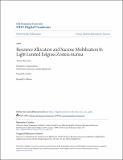Por favor, use este identificador para citar o enlazar a este item:
http://hdl.handle.net/10261/150050COMPARTIR / EXPORTAR:
 SHARE SHARE
 CORE
BASE CORE
BASE
|
|
| Visualizar otros formatos: MARC | Dublin Core | RDF | ORE | MODS | METS | DIDL | DATACITE | |

| Título: | Resource allocation and sucrose mobilization in light-limited eelgrass Zostera marina |
Autor: | Alcoverro, Teresa CSIC ORCID ; Zimmerman, Richard C.; Kohrs, Donald G.; Alberte, Randall S. | Palabras clave: | Resource allocation Light Seagrass Carbon balance Photosynthesis |
Fecha de publicación: | 1999 | Editor: | Inter Research | Citación: | Marine Ecology - Progress Series 187 : 121-131 (1999) | Resumen: | This study evaluated the ability of Zostera marina L. (eelgrass) to balance the daily photosynthetic deficit by mobilization of carbon reserves stored in below-ground tissues during a period of extreme winter light limitation. A quantitative understanding of the mobilization process and its limitations is essential to the development of robust models predicting minimum light levels required to maintain healthy seagrass populations. Plants were grown in running seawater tanks under 2 light regimes. One treatment was provided with 2 h irradiance-saturated photosynthesis (Hsat) to produce severe Light Limitation, while control plants were grown under 7 h Hsat, simulating the typical wintertime condition in Monterey Bay, California, USA. Although plants maintained under 2 h Hsat were more severely carbon limited than plants grown under 7 h Hsat, whole-plant carbon balance calculated from metabolic needs and growth rates was negative for both Hsat treatments. The eelgrass studied here responded to negative carbon balances by suppressing the production of new roots, depleting sucrose reserves, and effecting a gradual decrease in growth rate and an increase in the activity of sucrose synthase (SS, E.C. 2.4.1.13) in sink tissues in the terminal stages of carbon stress. The 7 h Hsat plants survived the 45 d course of the experiment while the plants grown under 2 h Hsat died within 30 d, even though one-third of their carbon reserves remained immobilized in the rhizome. Thus. extreme Light limitation can prevent full mobilization of carbon reserves stored in below-ground tissues, probably through the effects of anoxia on translocation. Metabolic rates, particularly photosynthesis and respiration of the shoot, were unaffected by prolonged carbon limitation in both treatments. The patterns observed here can provide useful indices for assessing the state and fate of seagrass ecosystems in advance of catastrophic declines. | Descripción: | Este artículo contiene 12 páginas, 9 figuras, 4 tablas. | Versión del editor: | http://dx.doi.org/10.3354/meps187121 | URI: | http://hdl.handle.net/10261/150050 | DOI: | 10.3354/meps187121 | ISSN: | 0171-8630 | E-ISSN: | 1616-1599 |
| Aparece en las colecciones: | (CEAB) Artículos |
Ficheros en este ítem:
| Fichero | Descripción | Tamaño | Formato | |
|---|---|---|---|---|
| Talcoverro 99.pdf | 1,05 MB | Adobe PDF |  Visualizar/Abrir |
CORE Recommender
SCOPUSTM
Citations
108
checked on 25-abr-2024
WEB OF SCIENCETM
Citations
100
checked on 29-feb-2024
Page view(s)
261
checked on 22-abr-2024
Download(s)
243
checked on 22-abr-2024
Google ScholarTM
Check
Altmetric
Altmetric
NOTA: Los ítems de Digital.CSIC están protegidos por copyright, con todos los derechos reservados, a menos que se indique lo contrario.
